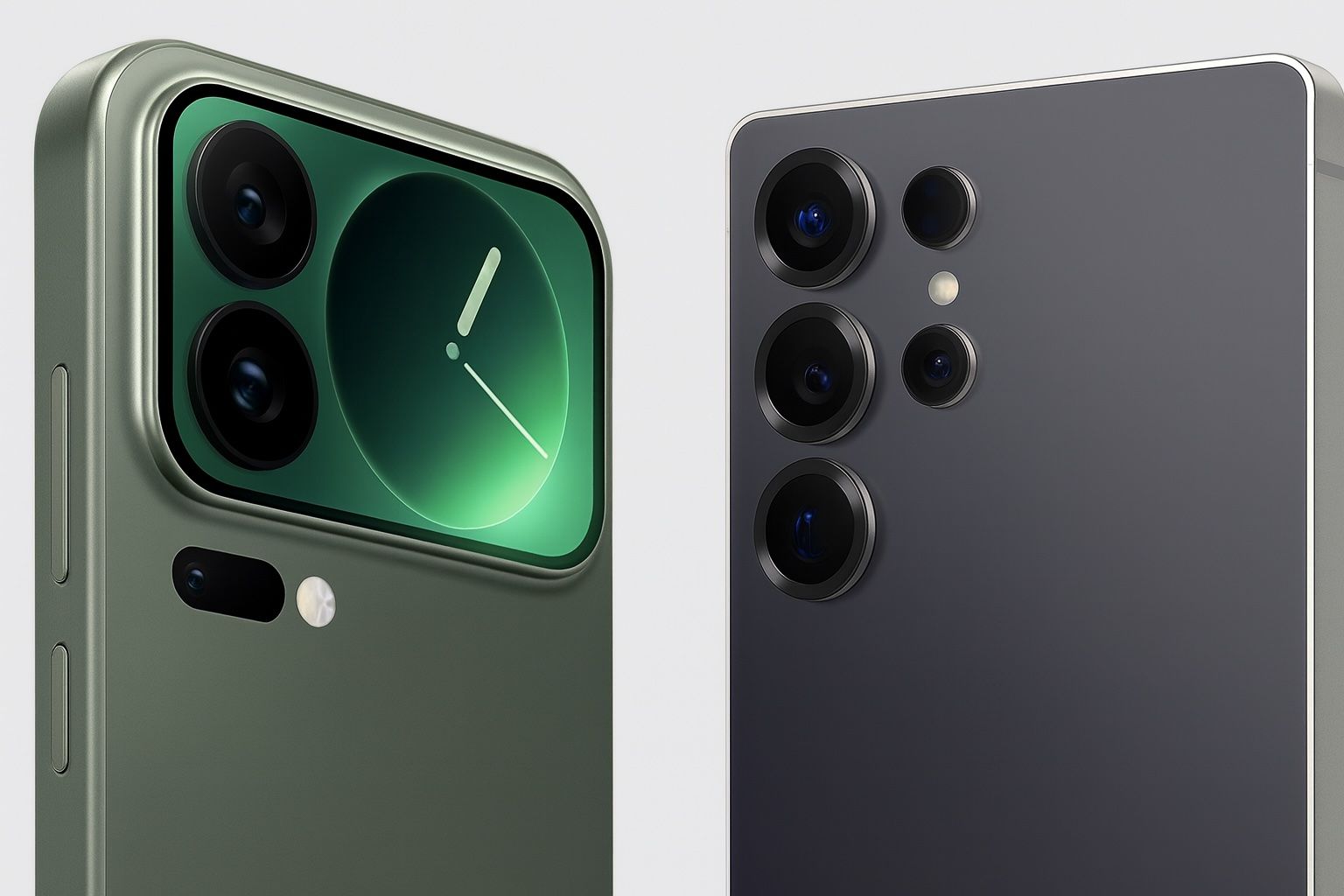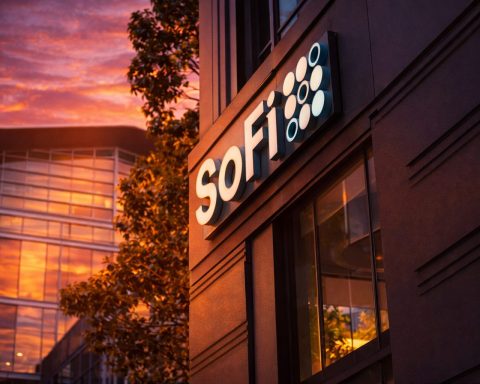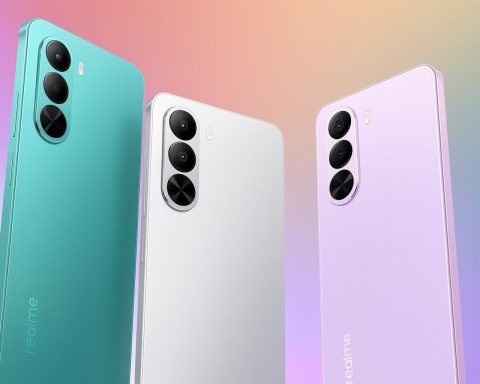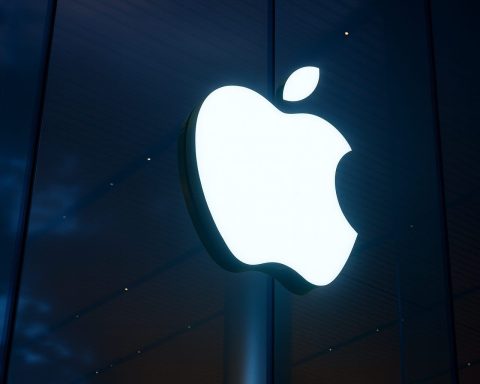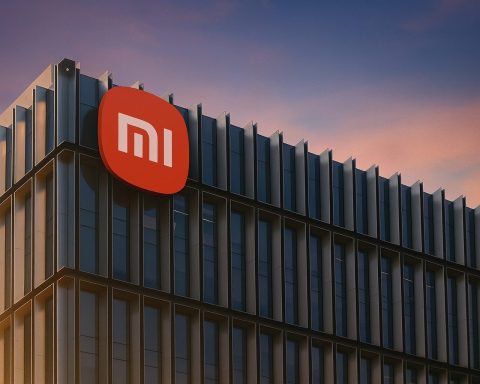- Battle of Titans: Xiaomi’s new 17 Pro Max is taking on Samsung’s Galaxy S25 Ultra in the 2025 flagship arena, bringing a massive 7,500 mAh battery and even a second screen on its back [1] [2]. Samsung’s S25 Ultra counters with a 200 MP camera, a custom AI-focused chip, and the refined experience of a global market leader [3] [4].
- Record Sales & Big Claims: In China, Xiaomi’s 17 series shattered first-day sales records – President Lu Weibing boasted it broke the 2025 “first-sale record” within minutes of launch [5]. Xiaomi’s CEO Lei Jun even claimed their 17 Pro/Max “wins on battery, performance, photography and more” when directly comparing to rivals [6]. Samsung, meanwhile, calls the S25 Ultra a “true AI companion” with context-aware smarts, showcasing the brand’s push into intelligent features [7].
- Hardware Showdown: On paper, Xiaomi’s 17 Pro Max outguns the Galaxy S25 Ultra in several areas – it has 50% more battery (7500 vs 5000 mAh) and debuts Qualcomm’s latest Snapdragon 8 Elite Gen 5 chip (up to 4.6 GHz) that one outlet calls “perhaps the fastest smartphone chip in the world” [8]. The Xiaomi also sports a unique 2.5-inch rear display for notifications, music controls, and even mini-games [9]. Samsung’s S25 Ultra fights back with arguably the best display on any phone (Forbes lauded its screen, plus “fast performance, all-day battery life, and an S Pen” in the package) [10], along with Samsung’s signature 100× Space Zoom and robust water-resistant build.
- Camera Duel: Both flagships pack powerhouse cameras but with different philosophies. Xiaomi uses a Leica-tuned triple-50MP array (upgraded sensors for ultra-wide and a 5× periscope telephoto with macro capability) [11], while Samsung wields a quad-camera setup headlined by a 200MP main sensor and dual telephoto lenses (including a high-res 5× zoom for up to 10× hybrid optical reach) [12] [13]. Early tests by experts show Xiaomi’s new 1/1.28-inch sensor capturing wider dynamic range than the S25 Ultra’s 200MP unit, giving it an edge in challenging lighting [14]. However, Samsung’s camera system is praised for its versatility – one reviewer noted the S25 Ultra is “more versatile and arguably just better” for overall photography than even its top competitor from Apple [15], hinting at how strong it remains against Xiaomi’s challenge.
- Software & Support: Xiaomi 17 Pro Max runs the new HyperOS 3 (Android 16) in China, with a fresh UI and AI tricks, but its global release is still uncertain [16] [17]. Samsung’s S25 Ultra launched with One UI 7 (Android 15) and a suite of “Galaxy AI” features that act as a personal assistant, plus Samsung guarantees 7 years of updates [18] – an industry-leading support window. In everyday use, Samsung’s software experience and integration (think S Pen productivity, Samsung DeX, etc.) remain a major selling point, while Xiaomi’s software is fast-improving but not as proven internationally.
Two Flagships, Two Different Strategies
Xiaomi’s 17 Pro Max and Samsung’s Galaxy S25 Ultra represent two divergent approaches to the ultimate smartphone. Xiaomi’s strategy is to win on specs and value – delivering bigger numbers and bold features at a lower price – whereas Samsung focuses on a balanced premium experience with global polish and cutting-edge AI integration. The result is a fascinating matchup that tech observers are watching closely in 2025.
Design & Display: At first glance, these phones look like typical big-screen flagships, but Xiaomi immediately stands out with its novel second screen on the back. This 2.5-inch “Dynamic Back Display” is embedded in the camera module, and it’s not just a gimmick – it can show time, notifications, music controls, serve as a selfie preview and even run simple games [19]. “We don’t need a second screen, but I’m already using it more than I expected to,” admits Wired’s Simon Hill after trying it [20]. In contrast, Samsung sticks to a more traditional design but exudes refinement: a sleek yet boxy titanium-framed build (now with flatter edges), IP68 water/dust resistance, and of course the built-in S Pen stylus for power users [21] [22]. Around front, both devices boast expansive 6.9-inch OLED displays with QHD-level resolutions and adaptive 120Hz refresh rates. Samsung’s panel has earned a reputation as best-in-class – DisplayMate and others report the S25 Ultra hits up to ~2600 nits brightness with stunning clarity, and Forbes calls it “the best display on a phone” [23]. Xiaomi’s screen is no slouch either, reaching 3500 nits peak brightness (according to Xiaomi) and using a new energy-efficient OLED material [24] [25]. Still, Xiaomi openly took inspiration from Apple’s iPhone design this year – even Xiaomi’s CEO joked that they skipped the number 16 to align with Apple’s naming [26] – but added their own twist via that rear display. Bottom line: Samsung offers a more polished, familiar luxury (with a killer screen and pen input), while Xiaomi serves up fresh innovation that literally flips the script to the phone’s backside.
Performance & Battery: Under the hood, these two are among the first phones powered by Qualcomm’s latest Snapdragon 8 Elite Gen 5 chipset – but Samsung uses a customized version of it for the Galaxy S25 series [27]. Samsung’s chip, co-developed with Qualcomm, is tuned for AI and graphics, enabling new multimodal AI agents that make the phone feel like a “true AI companion” as Samsung puts it [28]. Xiaomi’s implementation of the Snapdragon 8 Gen 5, on the other hand, is all about raw power – paired with up to 16GB RAM and advanced cooling. Notebookcheck notes this silicon is “perhaps the fastest smartphone chip in the world” right now [29]. In day-to-day tasks, both phones fly through apps and games, and can handle intensive multitasking with ease. The real differentiator, however, is battery life and charging. Xiaomi has armed the 17 Pro Max with an enormous 7,500 mAh battery – literally half again the capacity of the S25 Ultra’s ~5,000 mAh cell [30] [31]. This gives Xiaomi a clear advantage in endurance: the company claims over 22 hours of video playback on a charge for the base Xiaomi 17 (with 7,000 mAh) [32] [33], so the Pro Max can potentially go even further. Samsung’s battery is plenty solid – reviewers get all-day usage comfortably from the S25 Ultra, with one lab test giving around 14+ hours web use which is on par with or better than most rivals (only Apple’s latest iPhones have edged ahead in certain battery tests) [34]. But Xiaomi’s use of new silicon-carbon battery tech clearly pays off in capacity gains [35].
Charging is another win for Xiaomi on paper: the 17 Pro Max supports 100W fast charging (0–100% in roughly 25 minutes) and 50W wireless charging [36] – meaning a quick top-up can add hours of use. Samsung sticks to its conservative 45W charging (~65% in 30 minutes in real tests) and 15W wireless [37]. While Samsung finally added support for the newer Qi2 wireless standard and still offers convenient reverse wireless charging (to juice up your Galaxy Buds or watch on the phone’s back), it’s notably slower to refill than the Xiaomi. Power users will envy Xiaomi’s battery monster when it comes to pure endurance and speed. That said, Samsung’s optimizations and Snapdragon’s efficiency mean the S25 Ultra is no slouch – it delivers “all-day battery life” in practice, as Forbes noted [38], and the tighter integration of hardware-software (plus that slightly lower power screen) helps stretch its 5000 mAh as far as possible.
Cameras: In 2025, cameras remain a make-or-break feature for flagships, and here we see a fierce contest of megapixels vs tuning. Samsung’s Galaxy S25 Ultra continues the company’s pursuit of high resolution, carrying a whopping 200 MP main camera (1/1.3-inch sensor), alongside a 50 MP ultra-wide and two telephoto cameras (one 50 MP 5× periscope for long zoom, and a 10 MP 3× lens for portraits) [39]. This flexible quad-camera setup enables everything from 0.5× ultra-wide to 100× digital Space Zoom, maintaining Samsung’s edge in zoom capabilities. Xiaomi, partnering with Leica, took a different route: the 17 Pro Max features three 50 MP rear cameras – primary, ultra-wide, and periscope telephoto – all with Leica optics and color science. The Pro Max’s telephoto is enhanced with a larger sensor (1/2-inch) and brighter f/2.6 aperture, plus it doubles as a telemacro shooter that can focus at 30 cm for close-ups [40] [41]. On paper Xiaomi doesn’t reach Samsung’s extreme zoom range (5× optical versus Samsung’s 10× hybrid), but its high-res sensors and Leica tuning aim to deliver superb image quality in the common zoom ranges people use most (up to 10×). In fact, early camera comparisons have shown Xiaomi’s new “Light Hunter” 50 MP sensor excels in dynamic range: in side-by-side shots, highlights and shadows are handled better by the Xiaomi 17 Pro Max than by the S25 Ultra’s 200 MP shooter [42]. Even Samsung’s famed night mode might meet its match – tests indicate the Xiaomi 17 Pro/Max capture cleaner low-light zoom photos with less flare from light sources, whereas the S25 Ultra and iPhone struggled with more blur and artifacts [43] [44].
That said, Samsung’s cameras are battle-tested and versatile. The S25 Ultra can seamlessly switch through multiple zoom levels, and Samsung’s image processing – backed by AI – has been refined over generations. Reviewers often praise Samsung for consistency: you get ultra-wide shots, 3× portraits, 10× telephoto, all producing reliably good results. DxOMark did note the S25 Ultra, while strong, wasn’t number one in their rankings, indicating fierce competition this year [45]. But mainstream users and many experts still rate Samsung among the best all-round camera phones. As for video, Samsung supports up to 8K recording at 30fps, with improved stabilization, while Xiaomi’s focus has been on photography (its video is capped at lower resolutions, presumably). One interesting comment from an expert: in an iPhone vs Samsung shootout, the S25 Ultra’s camera system was called “more versatile, and arguably just better” than the iPhone’s for most scenarios [46]. That implies the Galaxy can certainly hold its own or beat other phones – meaning Xiaomi’s Leica cameras have a high bar to clear. All in all, Xiaomi seems to have closed the gap in camera tech (and may even surpass Samsung in certain metrics like dynamic range), but Samsung’s zoom prowess and software tuning remain major advantages.
Software & AI Features: Beyond the raw hardware, the user experience of these phones is shaped by their software. Samsung’s Galaxy S25 Ultra runs One UI 7 on Android, which in this generation heavily emphasizes on-device AI. Samsung introduced “multimodal AI agents” – think smart assistants that can understand context from your voice, camera, and habits combined [47]. The S25 Ultra proactively offers features like Now Brief widgets summarizing your day, improved voice assistants (integrating a new Google Assistant with Samsung’s Bixby), and even AI routines that automate tasks (e.g., if the phone detects you fell asleep with the TV on, it can turn off a Samsung TV) [48] [49]. It’s an ambitious push to make the smartphone smarter and more personalized. Xiaomi’s 17 Pro Max ships with HyperOS 3, Xiaomi’s latest Android 16-based interface, which is also infused with AI features (though perhaps not as deeply integrated as Samsung’s vision). Xiaomi’s software is known for heavy customization, and HyperOS is reportedly cleaner and faster than previous MIUI versions, with revamped design and new AI camera tricks and voice features [50]. However, being a China-first device, out of the box it lacks Google services and caters to Xiaomi’s ecosystem. A global version of HyperOS for the 17 series hasn’t been released yet – in fact, Xiaomi has not confirmed if the 17 Pro Max will launch internationally at all [51]. This is a critical point: Samsung’s S25 Ultra is available worldwide, with full Google integration and a reputation for timely updates (Samsung pledges 7 years of updates for the S25 Ultra [52], which actually beats Google’s and Apple’s support promises). Xiaomi’s flagships, by contrast, often see global releases delayed or limited – and some models like the 17 Pro Max might never officially leave China’s market (aside from importers). For a tech enthusiast willing to import and tinker, that’s fine, but for most consumers, Samsung’s out-of-the-box ease and support give it a big advantage in software experience.
That said, Xiaomi’s approach has its perks. The HyperOS software on the 17 Pro Max is expected to be feature-rich (with lots of customization, themes, and Xiaomi’s own AI assistant). And Xiaomi has shown commitment to unique ideas – for instance, integrating the rear display with software: you get cute AI wallpapers and dynamic notifications on the back screen [53] [54], and even a GameBoy-style mini console when paired with a special case. These playful touches highlight Xiaomi’s innovative streak, whereas Samsung’s software ethos is a bit more conservative (focused on polish and productivity). Ultimately, both phones run Android at heart, but the flavor is different – one is leaning into futuristic features, the other is refining and expanding what already works.
Price, Availability, and the X-Factors
One of the most striking differences between Xiaomi 17 Pro Max and Samsung Galaxy S25 Ultra is price. Xiaomi has aggressively priced its flagship in China: starting at ¥5,999 (around $840) for the base Pro Max model [55]. Even maxed out with 16GB RAM and 1TB storage, it’s under ~$1000. Samsung, on the other hand, launched the S25 Ultra at $1,199 (256GB) in the US market [56], and fully loaded versions can cross $1500. That means Xiaomi is offering comparable or superior hardware at roughly two-thirds the cost. It’s a classic disruptor model – but only if you can actually buy the phone. As mentioned, the 17 Pro Max is currently a China-exclusive. Global tech fans are hoping for an international release (perhaps under a different name or via Xiaomi’s usual later rollout), but no official global launch has been confirmed [57]. In fact, sources like Notebookcheck suspect the Pro Max might never get an official global version [58], possibly due to production limits or Xiaomi’s market strategy. By contrast, Samsung’s S25 Ultra is widely available across North America, Europe, and most of Asia, backed by carrier deals and support networks. This difference can’t be ignored: a phone that’s half the price doesn’t help consumers if they can’t easily purchase it or get after-sales service in their country.
For those who can choose between them, it may boil down to what you value more. If you crave cutting-edge specs and innovation per dollar, Xiaomi 17 Pro Max makes a strong case. It’s a phone that, as one headline put it, “shocks the flagship scene” by piling on features – giant battery, dual screens, top chip – at a relatively affordable price [59]. It’s also a symbol of how Chinese manufacturers are pushing boundaries, as seen by the record sales and enthusiastic domestic reception (the 17 series selling out in minutes and prompting Xiaomi to continue the rear-display design in future models [60] [61]). On the other hand, Samsung’s Galaxy S25 Ultra offers a proven, premium experience that justifies its cost in less flashy ways: a superb build, likely better long-term reliability, robust customer support, and an ecosystem (Galaxy Watch, Buds, tablets, SmartThings appliances, etc.) that integrates seamlessly. There’s also the matter of brand trust – Samsung has been a flagship leader for over a decade, while Xiaomi is still building its high-end reputation outside of China. Corporate users or those who rely on things like Samsung’s Knox security and support might lean towards the S25 Ultra, whereas tech enthusiasts might be willing to experiment with Xiaomi’s beast.
Finally, consider a few intangibles. The Galaxy S25 Ultra benefits from Samsung’s software finesse – little things like smoother animations, less bloat in global models, and features like Samsung DeX (which turns the phone into a desktop PC interface) add to its appeal for power users. Xiaomi’s 17 Pro Max, meanwhile, wins the “cool factor” – it’s the phone that turns heads with a tiny rear screen and crazy battery endurance. That novelty shouldn’t be underestimated in a year when most phones look and feel iterative. Even veteran tech reviewers have expressed surprise and delight at Xiaomi’s secondary display, calling it more useful than expected [62]. It shows Xiaomi isn’t afraid to try new ideas, and sometimes they pay off.
Conclusion: Who Wins 2025’s Flagship Face-off?
In the battle of Xiaomi 17 Pro Max vs Samsung Galaxy S25 Ultra, the winner depends on your perspective. On pure specs and value, Xiaomi’s 17 Pro Max is a knockout – it offers more (more battery, more features, more pixels per dollar) and has validated its prowess by breaking sales records and impressing early adopters [63] [64]. It’s arguably the most advanced hardware in any smartphone this year [65], and it signals where the industry could be headed (larger batteries, secondary displays, new battery tech). However, Samsung’s Galaxy S25 Ultra holds its ground as the more well-rounded flagship for most users. Samsung brings advantages that aren’t as easily quantifiable: a world-class display, a trusted camera system, a polished OS with years of updates, and global availability with strong support. As tech journalist Prakhar Khanna put it, the S25 Ultra offers “the best display on a phone, fast performance, all-day battery life, and an S Pen” – yet some consider it a bit “boring” because it’s so refined and predictable [66]. But for many buyers, refinement over surprise is exactly what they want in a $1200 device.
In summary, if you’re an innovation seeker or power user on a budget, the Xiaomi 17 Pro Max (if you can get your hands on one) is an absolute delight – a phone that pushes the envelope and forces industry leaders to respond. If you’re a professional or mainstream user who needs a reliable, well-balanced phone with broad support, the Samsung Galaxy S25 Ultra remains a top-tier choice that is hard to bet against. As an expert at Android Central observed, Xiaomi’s rise with the 17 series shows that the company is “looking at what it’s done” right and doubling down on it [67] – and indeed, 2025 might be remembered as the year Xiaomi truly went after the crown. But for now, Samsung’s Ultra still wears the crown in the global market, even if its challenger has made the throne a lot less comfortable.
One thing is certain: this rivalry is heating up, and consumers are the real winners. With Xiaomi innovating aggressively and Samsung upping its game with AI and long-term support, the stage is set for an exciting era of smartphones where no one brand can rest easy. As we head into 2026, the question isn’t just which flagship wins today, but how much these two tech giants will keep leapfrogging each other – and that competition is a win for all of us who live on the cutting edge of mobile technology.
Sources: Xiaomi and Samsung official announcements; Android Central [68] [69]; Notebookcheck [70] [71]; Tom’s Guide [72] [73]; TechStock² (ts2.tech) [74] [75]; Forbes via Bing [76]; The Verge [77].
References
1. ts2.tech, 2. www.tomsguide.com, 3. ts2.tech, 4. news.samsung.com, 5. www.androidcentral.com, 6. www.tomsguide.com, 7. news.samsung.com, 8. ts2.tech, 9. ts2.tech, 10. www.forbes.com, 11. ts2.tech, 12. ts2.tech, 13. www.samsung.com, 14. www.notebookcheck.net, 15. ts2.tech, 16. ts2.tech, 17. ts2.tech, 18. ts2.tech, 19. ts2.tech, 20. ts2.tech, 21. ts2.tech, 22. ts2.tech, 23. www.forbes.com, 24. www.notebookcheck.net, 25. www.notebookcheck.net, 26. www.tomsguide.com, 27. news.samsung.com, 28. news.samsung.com, 29. ts2.tech, 30. ts2.tech, 31. ts2.tech, 32. www.tomsguide.com, 33. www.tomsguide.com, 34. www.tomsguide.com, 35. www.tomsguide.com, 36. ts2.tech, 37. ts2.tech, 38. www.forbes.com, 39. ts2.tech, 40. ts2.tech, 41. ts2.tech, 42. www.notebookcheck.net, 43. www.notebookcheck.net, 44. www.notebookcheck.net, 45. www.dxomark.com, 46. ts2.tech, 47. news.samsung.com, 48. ts2.tech, 49. ts2.tech, 50. ts2.tech, 51. www.notebookcheck.net, 52. ts2.tech, 53. www.androidcentral.com, 54. www.androidcentral.com, 55. ts2.tech, 56. ts2.tech, 57. www.notebookcheck.net, 58. www.notebookcheck.net, 59. ts2.tech, 60. www.androidcentral.com, 61. www.androidcentral.com, 62. ts2.tech, 63. www.androidcentral.com, 64. www.tomsguide.com, 65. www.notebookcheck.net, 66. www.forbes.com, 67. www.androidcentral.com, 68. www.androidcentral.com, 69. www.androidcentral.com, 70. www.notebookcheck.net, 71. www.notebookcheck.net, 72. www.tomsguide.com, 73. www.tomsguide.com, 74. ts2.tech, 75. ts2.tech, 76. www.forbes.com, 77. www.tomsguide.com
